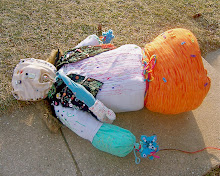 Although, I finished reading the article and understood the majority of the text I had one question or maybe two. But the question that looped through my brain continuously was(drumroll)...What does that mean? Words and phrases like: hypertext, hypermedia, computer hobbyist, CCXlceptUal framework, HTML, HTTP, Usenet, Trojan Room Coffee Pot, JenniCam and ARPANET.
Although, I finished reading the article and understood the majority of the text I had one question or maybe two. But the question that looped through my brain continuously was(drumroll)...What does that mean? Words and phrases like: hypertext, hypermedia, computer hobbyist, CCXlceptUal framework, HTML, HTTP, Usenet, Trojan Room Coffee Pot, JenniCam and ARPANET.I began to Google everything. I was on a quest to find out more information to deepen my understanding of the article (The Internet and the World Wide Web by Jeremy G. Butler). Ok here goes...
Hypertext- A database system that enables text, music, pictures, programs and so on to be linked to each other. Hypertext is useful for organizing and browsing large databases that consist of various types of information.
Hypermedia- A database system that broadens the idea of hypertext. Hypermedia enables any set of multimedia objects to be linked together such as sound, motion video and virtual reality.
Computer Hobbyist- A person who is fascinated with computer technology. A computer hobbyist's entire life revolves around computers. Computer hobbyist are not just consumers but builders also. They build machines just for the sake of building and not for profit. They attend computer shows with the hope to admire new parts and not to be pressured into buying.
An anonymous computer hobbyist on PC Mag.com stated, "Perhaps the hobbyist is not gone, but merely changed...Many of us are still hobbyists, but the hobby is different. We build stuff to DO stuff, whereas before we built it to build it. I still go to computer shows and buy parts, as do some of my friends. We still take pleasure in just building machines. Of course, the shows are a great place to see just how much things have changed...the people attending the shows are different, perhaps more 'consumer' than 'hobbyist', and the vendors are completely alien to what we had in the 80's (where the typical vendor was someone just as fascinated with the technology as yourself, who would talk with you for hours if you let them, rather than someone looking for a quick buck and offering no service). It really has shifted from a 'system' perspective to a 'use' perspective. 'They joy of figuring things out' has been supplanted by the need to have access and the need to have a 'better rig' than everyone else. In part, perhaps, the PC hobby has been destroyed by the MicroSoft mentality...their obscene business tactics have not only tainted other areas of business in America, it has generated a similar 'must conquer all others' mentality in users as well. Most people conform to the MS way of doing things, and desire the 'standard' system: Windows and Word. And the hobbyist types have also fallen into that W&W approach to PC's, except the ones I mentioned above."
CCXlceptUal framework- Unfortunately, I could not find anything on CCXL framework.
HTML- HTML is the acronym for Hypertext Markup Language. HTML is a computer language that enables website creation through a series of short codes.
HTTP- HTTP is the acronym for Hypertext Transfer Protocol. As soon as you access a website, you are indirectly using HTTP. It is a set of rules for transferring files such as text, sound, video, and other multimedia files on the World Wide Web.
Usenet- Usenet is a worldwide system of discussion groups in which millions can participate for free.
Trojan Room Coffee Pot- It was a project that used a camera to capture a coffee pot every few seconds at various resolutions. This project is known as the beginning of the webcam.
JenniCam- Jennifer Kaye Ringley used a webcam to make her life completely accessible to the World Wide Web. Jennifer did not filter any footage. The site was popular from April 1996 to late 2003. Jennifer is known as a conceptual artist.
ARPANET- ARPANET is an acronym for Advanced Research Projects Agency Net. ARPANET is the forerunner to the Internet and originally funded by the Defense Department. It was an experimental network developed by the US Department of Defense in the late 1960s. It was used to create a communications link that would allow ARPA (Advanced Research Projects Agency) scientists and research contractors to share their resources and ideas. The network was created to survive breakdown in case of a nuclear attack.


























